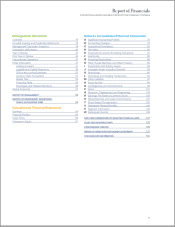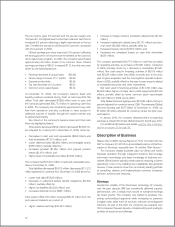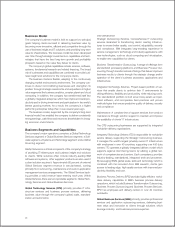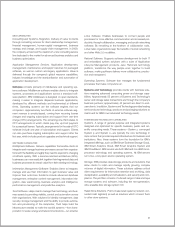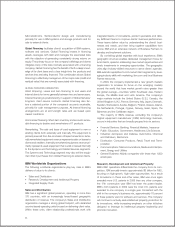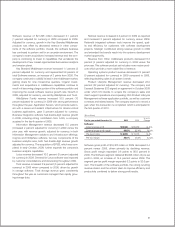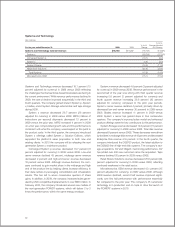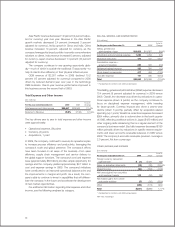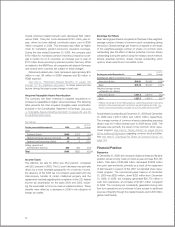IBM 2009 Annual Report Download - page 26
Download and view the complete annual report
Please find page 26 of the 2009 IBM annual report below. You can navigate through the pages in the report by either clicking on the pages listed below, or by using the keyword search tool below to find specific information within the annual report.
Microelectronics. Semiconductor design and manufacturing
primarily for use in IBM systems and storage products and for
sale to external clients.
Global Financing facilitates clients’ acquisition of IBM systems,
software and services. Global Financing invests in financing
assets, leverages with debt and manages the associated risks
with the objective of generating consistently strong returns on
equity. The primary focus on the company’s offerings and clients
mitigates many of the risks normally associated with a financing
company. Global Financing has the benefit of both a deep knowl-
edge of its client base and a clear insight into the products and
services that are being financed. This combination allows Global
Financing to effectively manage two of the major risks (credit and
residual value) that are normally associated with financing.
GLOBAL FINANCING CAPABILITIES
Client Financing. Lease and loan financing to end users and
internal clients for terms generally between two and seven years.
Internal financing is predominantly in support of Global Services’
long-term client service contracts. Global Financing also fac-
tors a selected portion of the company’s accounts receivable,
primarily for cash management purposes. All internal financing
arrangements are at arm’s-length rates and are based upon
market conditions.
Commercial Financing. Short-term inventory and accounts receiv-
able financing to dealers and remarketers of IT products.
Remarketing. The sale and lease of used equipment to new or
existing clients both externally and internally. This equipment is
primarily sourced from the conclusion of lease transactions. Exter-
nally remarketed equipment revenue represents sales or leases to
clients and resellers. Internally remarketed equipment revenue pri-
marily represents used equipment that is sold or leased internally
to the Systems and Technology and Global Services segments.
The Systems and Technology segment may also sell the equip-
ment that it purchases from Global Financing to external clients.
IBM Worldwide Organizations
The following worldwide organizations play key roles in IBM’s
delivery of value to its clients:
• Sales and Distribution
• Research, Development and Intellectual Property
• Integrated Supply Chain
Sales and Distribution
IBM has a significant global presence, operating in more than
170 countries, with an increasingly broad-based geographic
distribution of revenue. The company’s Sales and Distribution
organization manages a strong global footprint, with dedicated
country-based operating units focused on delivering client value.
Within these units, client relationship professionals work with
integrated teams of consultants, product specialists and deliv-
ery fulfillment teams to improve clients’ business performance.
These teams deliver value by understanding the clients’ busi-
nesses and needs, and then bring together capabilities from
across IBM and an extensive network of Business Partners to
develop and implement solutions.
By combining global expertise with local experience, IBM’s
geographic structure enables dedicated management focus for
local clients, speed in addressing new market opportunities and
timely investments in emerging opportunities. The geographic
units align industry-skilled resources to serve clients’ agendas.
IBM extends capabilities to mid-market client segments by lever-
aging industry skills with marketing, ibm.com and local Business
Partner resources.
In 2008, the company implemented a new growth markets
organization to increase its focus on the emerging markets
around the world that have market growth rates greater than
the global average—countries within Southeast Asia, Eastern
Europe, the Middle East and Latin America. The company’s
major markets include the United States (U.S.), Canada, the
United Kingdom (U.K.), France, Germany, Italy, Japan, Denmark,
Sweden, Switzerland, Austria, Belgium, Finland, Greece, Ireland,
the Netherlands, Portugal, Cyprus, Norway, Israel, Spain, the
Bahamas and the Caribbean region.
The majority of IBM’s revenue, excluding the company’s
original equipment manufacturer (OEM) technology business,
occurs in industries that are broadly grouped into six sectors:
• Financial Services: Banking, Financial Markets, Insurance
• Public: Education, Government, Healthcare, Life Sciences
• Industrial: Aerospace and Defense, Automotive, Chemical
and Petroleum, Electronics
• Distribution: Consumer Products, Retail, Travel and Trans-
portation
• Communications: Telecommunications, Media and Entertain-
ment, Energy and Utilities
• General Business: Mainly companies with fewer than 1,000
employees
Research, Development and Intellectual Property
IBM’s R&D operations differentiate the company from its com-
petitors. IBM annually invests approximately $6 billion for R&D,
focusing on high-growth, high-value opportunities. As a result
of innovations in these and other areas, IBM was once again
awarded more U.S. patents in 2009 than any other company,
the 17th consecutive year IBM has been the patent leader.
IBM’s 4,914 patents in 2009 were the most U.S. patents ever
awarded to one company in a single year. Consistent with the
shift in the com pany’s business mix, approximately 70 percent
of these patents were for software and services. The company
will continue to actively seek intellectual property protection for
its innovations, while increasing emphasis on other initiatives
designed to leverage its intellectual property leadership and
promote innovation.
24





